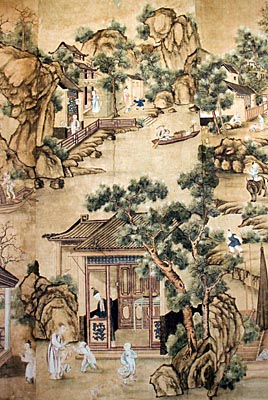 |
 |
|||
|
|
The Talbots agreed to sell Shaw House to the 1st Duke of Chandos in 1720. The Duke was one of the most stylish and flamboyant, not to mention richest, men of the age. His main residence was Canons, an extravagant house at Stanmore in Middlesex, but he saw Shaw as a convenient stopping place between London and Bath and for visiting relatives in the Cotswolds. He must have liked the place because legal complications meant he was not able to take possession of his new Berkshire property for some eight years, yet he persisted with the purchase. The house had probably been empty for nearly twenty years, so there was much repair work to be undertaken. Chandos employed a Newbury mason named Jonathan Hicks to fix and roof and replace the mullion windows with sashes. Then the London architect, Edward Shepherd, was engaged to update the parlour and the 'Old Queen's Bedroom' which the Dolmans had been at such pains to preserve unchanged. The parlour became the Duke's new dining room, decorated with Chinese wallpaper in plasterwork frames. The frames survive and restored copies of contemporary paper now give a real feel for the room's former splendour. The other major change, introduced by Chandos, was the insertion of two remarkable little rooms, accessed from the Queen Anne suite. They originally contained some of the earliest flush toilets in the country. So Shaw had not only style, but comfort. Chandos and his second wife, Cassandra, were apparently very happy at Shaw and would spend up to six weeks of the year there in the Summer. But the Duke also wanted to use the estate's agricultural potential, growing such exotic produce as pineapples there and making attempts at exploiting both timber and peat. He rarely visited after Cassandra's death and, after three years, rented the house to his son, the Marquis of Caernarfon, who famously 'bought' his second wife at the Pelican Inn in Newbury. When the Duke died in 1744, the Shaw House went to his third duchess, Lydia Catherine, who was apparently resident as she is buried in the the parish church. Victorian Additions After
the Duchess' death, the house was sold to the former Paymaster of the Forces
in Scotland, Joseph Andrews, for just over £27,000 (that's about £2¼m.
today).
He was a meticulous record keeper and left some fascinating sketches of life
at Shaw and his plans for the house, which can now be seen in the exhibition
room. Sadly, he died before any of them could be started. His son and
namesake was created a baronet in 1766. Neither he nor his nephew, made any
significant changes to the property but, as we have seen, the historian
father of the latter influenced the renaming of a number of the
rooms along historical lines. In total, the estate was held by the Andrewses
for seventy years, before passing to a cousin, Rev. Thomas Pentrose, who
visited occasionally but most lived in Essex, and then to his nephew, Henry
Eyre. The Eyres were a Hampshire family, unrelated to those from Welford
Park, and lived at Shaw House throughout the Victorian period. With
a large family and in excess of ten servants, it was Henry Eyre who
subdivided the old long gallery on the top floor to provide additional
accommodation, including a nursery. An
open loggia was then added at the back of the property, with an enclosed storey above
that functions as a
corridor running the
Later History Shaw House was purchased by Mrs. Kathleen Farquhar. She had the loggia glazed in and installed electricity in time for 'Country Life' magazine to file a full report on the place in 1910. Like so many other great houses, it was requisitioned, from her grandson, for military billeting during the Second World War. Then the Newbury Senior Council School moved in when its premises were bombed and it remained a school, for many years a girl's school, until this withdrew to the surrounding buildings due to concerns over the houses' safety. Berkshire County Council had purchased the property in 1949 and it passed to West Berkshire Council in 1998. An extensive programme of restoration commenced in 2005 and Shaw House now has a new life as a conference centre and visitor attraction, including local council offices and the registry office. Shaw House belongs to West Berkshire Council . It is open to the public on most weekends and school holidays. All photographs
taken by kind permission of West Berkshire
Council.
|
|||
| © Nash Ford Publishing 2011. All Rights Reserved. | ||||




 The
Duke's Country Residence
The
Duke's Country Residence
